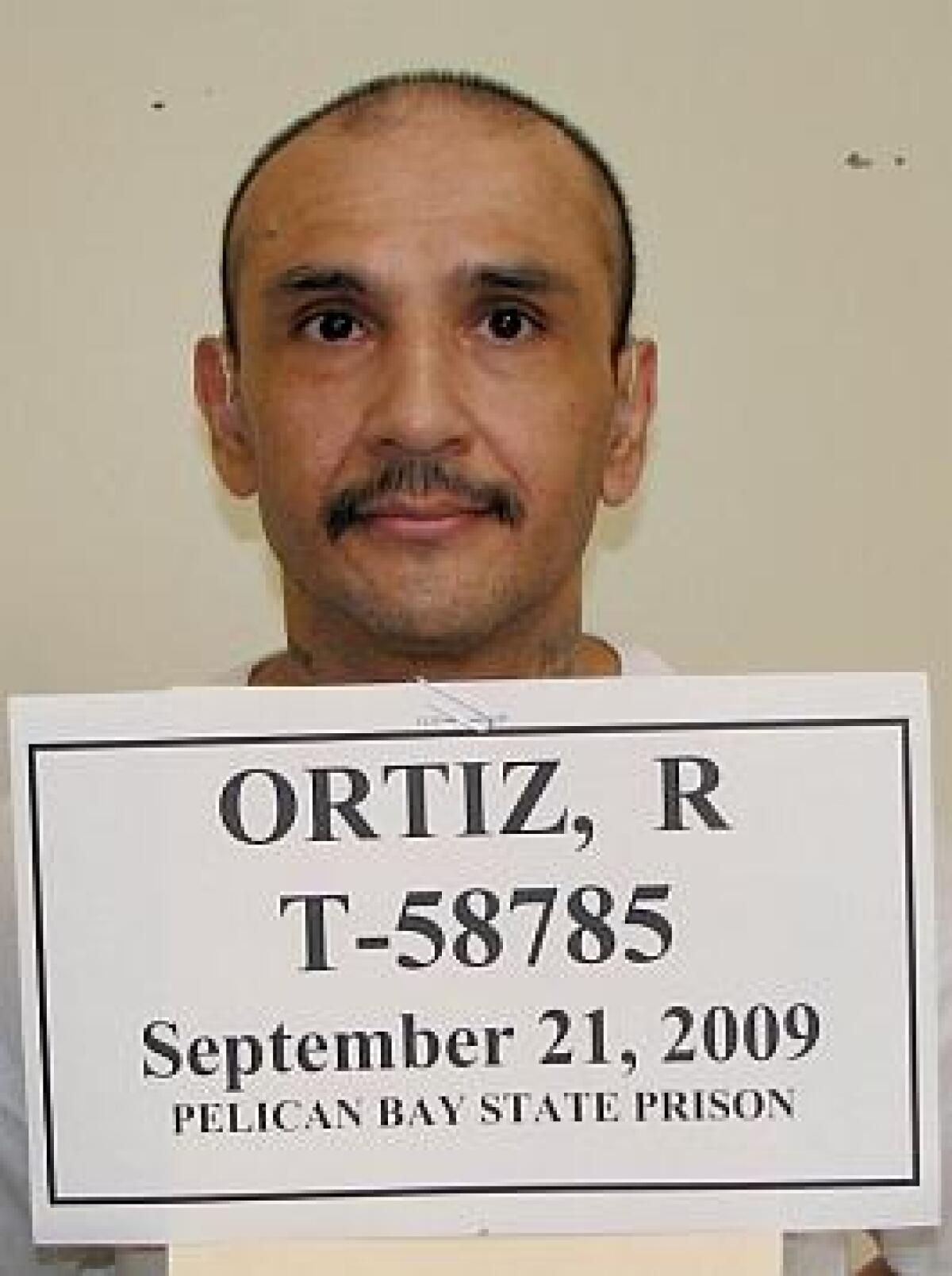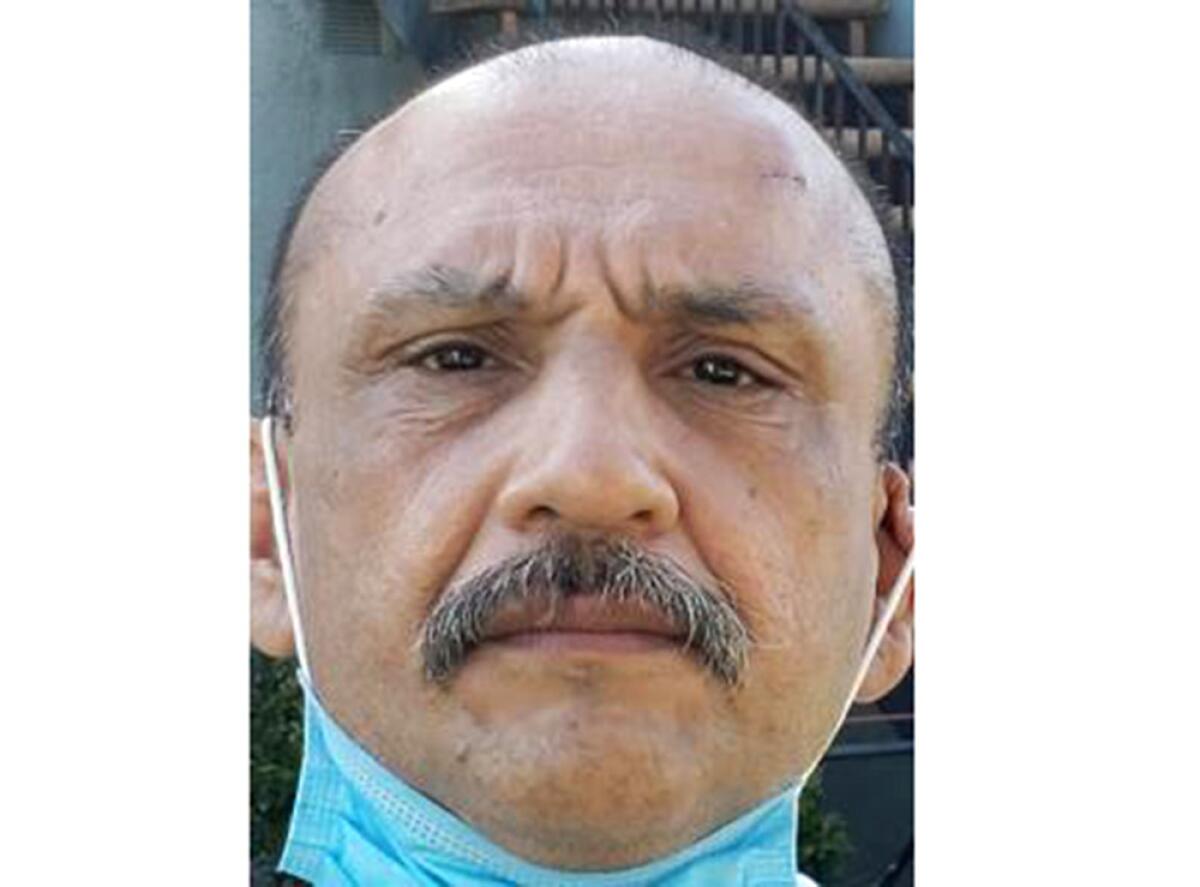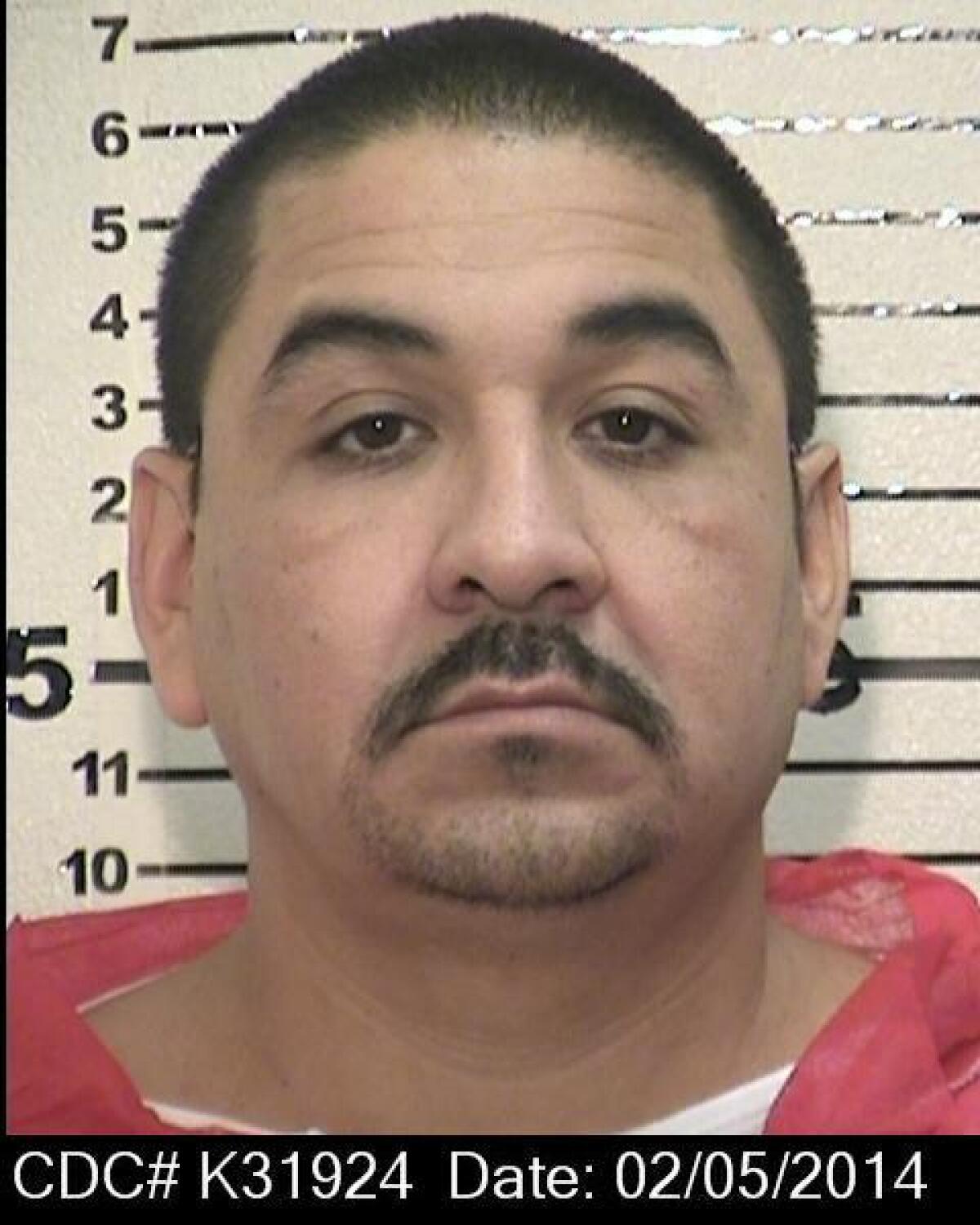‘If you eat a butterfly, you become a butterfly’: Hearing reveals details of Mexican Mafia killing

They looked just like any other couple getting on in age, walking along a suburban street in the last hours of daylight.
They had met in the fourth grade. He went to prison; she got on with her life. Over the years, she heard rumors that he’d become affiliated with the Mexican Mafia.
When he got out of prison for the last time, 50 years after they first met, she asked if he’d left all that behind. She wanted to believe him when he said yes.
But the past caught up to Donald Ramon Ortiz that afternoon. It came disguised as a detective, holding a gun in a gloved hand.
The last moments of Ortiz’s life were recounted at a hearing over the last two weeks in the case that San Bernardino County prosecutors have brought against his accused killer. At the end of it, a judge ruled that he’d seen enough evidence to hold the defendant to answer on all charges and allegations.
Over two days of testimony, prosecutors made the case that Ortiz was assassinated by the Mexican Mafia. Authorities described evidence that not only tied the alleged killer to the prison gang but suggested he’d been promised membership in the organization for murdering Ortiz, a so-called “dropout.”
“The consequence for being a dropout — the only consequence the Mexican Mafia will tolerate — is death,” a detective testified.
Coming up in the Whittier Varrio Locos gang, the 5-foot-6 Ortiz got the nickname “Little Man.” He spent most of his 59 years in juvenile halls, youth camps, reform schools, county jails and state prisons.
Inducted into the Mexican Mafia in the 1980s, Ortiz was later cast out of the organization and targeted for murder. Beaten and stabbed in prison, he refused to go to the authorities for protection.
This earned the respect of one Mexican Mafia member, who wrote in a letter in 1998: “Lil Man from Whittier, now there a vato who everybody and there grandma knew was on the lista” — the hit list — “and he signed that paper and they still let him out not once but twice and both times he got wacked and he still wanted to come back to the yard.”
When Ortiz was released in 2019, he reconnected with the woman he’d met in elementary school and eventually moved into her apartment in Chino. Hoping to keep Ortiz from slipping into old habits, the woman — identified in court only by her initials — didn’t allow his friends from Whittier to visit.

Just after 4 p.m. on Nov. 19, 2021, she was walking back from the store with Ortiz when they saw a man lingering on the grass outside her building on Philadelphia Street.
Dressed “like a businessman,” he held what looked like a business card in a gloved hand, she testified.
The man asked if he was Donald Ortiz. He said he was.
“We need to talk to you about a homicide,” the man said. Ortiz said he didn’t know anything about one.
“Are you sure you want to talk in front of her?” the man asked.
Then she saw the gun.
She closed her eyes and plugged her ears with her fingers. She heard several shots.
“I stood there with my eyes closed,” she recalled, crying quietly, “waiting to be shot next. I stood there for what seemed like a long time. When I opened my eyes, I saw him walking away.”
Ortiz lay in the gutter, shot in the head, a detective testified. Two 9-millimeter casings were found near his body.
The prosecutor asked the woman if she recognized Ortiz’s killer in the courtroom. The defendant, Cesar Palomino, sat about 20 feet from her, dressed in an orange jumpsuit and draped in shackles.
“I don’t believe so,” she said.
William Drake, a deputy public defender, seized on her failure to identify his client in arguing for the judge to dismiss the murder charge. But detectives would describe other evidence — DNA, cellphone records, internet searches, surveillance video and jail calls — that indicated the man at the defense table was Ortiz’s killer.
A detective for the Chino Police Department had reviewed the internet search history for Palomino’s accounts. Before Ortiz was killed, someone using the accounts had looked up “Donald Ortiz,” “Mexican Mafia Little Man” and “Eme dropouts,” the detective testified. The day after Ortiz’s death was a search for “Chino local news.”
Like the man he is accused of murdering, Palomino, 50, spent much of his life behind bars. He served brief terms for low-level drug and weapons offenses and longer stretches in federal prison for entering the country illegally.
Records filed in these immigration cases describe a life spent with one foot on either side of the U.S.-Mexican border.
The oldest of three children, Palomino was born in Acapulco, according to a report filed in a deportation case whose author, a Stanford psychology professor, interviewed Palomino in a Las Vegas jail in 2004.
At 9, Palomino’s mother took the three kids to join their father, who had found work in California installing cable television lines. The family settled in Long Beach. Not wanting to appear “dumb” to his American cousins, Palomino learned English quickly, the professor wrote. He attended public schools in Long Beach, Lakewood and Bellflower until the 11th grade, when, for reasons left unexplained in the report, he was expelled.
Palomino described himself as a “history fanatic” and avid reader who liked novels by John Grisham and Sidney Sheldon.
“I’m Mexican born, but inside I’m American,” he said, according to the report. “I don’t know anything else. This is just how I feel. I’m American, I guess, in every way, except they tell me in nationality.”
At 19, Palomino was arrested for carrying a sawed-off shotgun, court records show. A prosecutor wrote in a sentencing memo that Palomino had joined Barrio Pobre, a small Long Beach gang.
His mother, pleading to a judge for leniency in another case many years later, wrote in a letter: “Only God knows how he was attacked by gangs until he fell prey to their claws, and I as an ill mother suffer the pain, along with his wife and children.”
Convicted of possessing the shotgun, Palomino was ordered deported but released pending an appeal. He failed to turn himself in after the challenge proved unsuccessful and was considered “an absconder illegally in this country,” a prosecutor wrote in a sentencing memo.
Five years later, Palomino pulled a blue Mitsubishi truck into the Mexican side of the Calexico Port of Entry. He told an inspector he’d driven to Mexico from Los Angeles two days earlier to install antennas in Mexicali. The luggage in the truck, he volunteered, belonged to his business partner.
There was no luggage in the truck, however, and the inspector noticed that Palomino’s hands were shaking, according to an affidavit filed in federal court. Authorities searched the truck and found 28 cellophane-wrapped bundles of marijuana, about 60 pounds in all, the affidavit says. Palomino admitted he’d been paid $2,000 to deliver the load to Los Angeles.
Deported in 2002, he waited not even a month before crossing back into the United States, according to an affidavit filed in court.
Palomino’s wife, whom he’d met at 17, was raising their three children, working as a dental hygienist in Las Vegas and pulling shifts at casinos to make ends meet, the professor wrote in his report.
“I wanted to come back because I was pretty much lost there without my family,” Palomino told him. “I didn’t know what to do in Mexico. I didn’t have a plan for staying there.”
Palomino would be deported and arrested for illegal reentry three times, records show. The last time, a judge sent him to federal prison in 2013 for seven years and ordered him returned to Mexico.
“One thing I can guarantee you,” Palomino wrote in a letter to the judge, “is I’m never coming back to the U.S.”
After Ortiz’s death, authorities obtained what is called a “geofence” warrant, which requires a technology company to turn over a list of all cellphones active in a particular area and time frame.
Based on surveillance video, detectives believed Ortiz’s killer drove a white Infiniti Q50 sedan. Combing through the data from the warrant, they found only three phone accounts had been at several locations where the Infiniti had been spotted, said Det. Alex Blanco of the Chino Police Department. The accounts, Blanco said, were associated with one person: Palomino.
The day Ortiz died soon after 4 p.m., Palomino’s phone was in Hesperia, where his family lived, at 2:30 p.m., Blanco testified. Geolocation data showed the phone traveled along the 15 and 60 freeways, exiting at Central Avenue in Chino at 4:06 p.m.
Twenty minutes later, the phone arrived at a street behind Ortiz’s apartment complex and transmitted no signal for about 20 minutes, indicating it had been turned off, Blanco said. By 7 p.m. the phone had returned to Hesperia.
Detectives sent the two casings found near Ortiz’s body for DNA testing, which confirmed Palomino’s DNA was on the expended shells, Blanco said.
Authorities arrested Palomino in Las Vegas in April 2022 and searched his home, where they found a black blazer and “black Italian dress boots” that resembled those worn by the man captured in surveillance video fleeing the scene of the crime, the detective testified.
Extradited to San Bernardino, Palomino made a call from county jail. According to Christopher Bean, a detective for the San Bernardino County Sheriff’s Department, he told an unidentified relative: “They told me if you eat a butterfly, you become a butterfly.”
The butterfly, whose wings form the shape of an ‘M,’ is one of the Mexican Mafia’s symbols. Bean said he believed Palomino had been told that if he killed a Mexican Mafia member — Ortiz — he would become one himself.
Detectives found evidence tying Palomino to Manuel Quintero, whom Bean described as “known, active member” of the Mexican Mafia whose nickname is Snuffy.

While going through Palomino’s text messages, detectives found an exchange from March 2022 in which Palomino asked a woman for help registering a car that he said was a gift from Quintero.
Then there was a jail call made by an inmate in the same module as Palomino.
Bean testified that the inmate, David Mendivil, told his spouse: “I’m here with Snuffy’s primo. You know that dropout, Little Man?”
She said yes.
“He got him,” Mendivil said, according to Bean. “He got him, baby.”
It’s unclear what Mendivil meant when he said Palomino was Quintero’s “primo.” In the literal sense it would mean they were cousins, but it could also mean they were associates or friends.
Ordered to appear in court to explain the call, Mendivil settled into the witness stand with the enthusiasm of a dental patient expecting a root canal.
Deputy Dist. Atty. David Collins opened a line of questioning: Do you recognize the defendant? Did he threaten to stab you for “dry-snitching”? Do you know someone called Snuffy? Is the defendant Snuffy’s “primo”?
To each question, Mendivil’s answer was the same: “I plead the 5th.”
His response changed only once, when Collins asked if he was afraid to be in court. “No,” he said.
After Collins offered Mendivil immunity and promised not to use his statements against him, Superior Court Judge Dan Detienne ordered him to testify and warned he’d be jailed for contempt of court if he refused.
Mendivil was in a terrible position. If he answered the prosecutor’s questions, he would be “in great, great, great danger and surely would be targeted for death,” Bean testified.
Mendivil chose jail. He bowed his head as the bailiff handcuffed him and led him away.
After sitting in jail for a weekend, Mendivil was brought back into court in a jumpsuit and shackles. Collins posed more questions, Mendivil’s answer did not change, and the bailiff returned him to the holding cell.
The prosecution’s most curious witness was a hobbled 77-year-old man with poor hearing and eyesight damaged by diabetes.
Collins asked the witness if he saw his son in court. “Of course,” Aquiles Palomino said in Spanish, pointing. “There he is.”
Asked to identify the color of his son’s jumpsuit, the old man seemed uncertain: “Is it pink? Is it red?”
“He’s blind,” his son muttered.
Eleven years earlier, Aquiles Palomino had urged a judge to take mercy on his son, who was facing sentencing for reentering the country illegally. “He is a good young man,” the father wrote, “but because of destiny he took the wrong path. We have tried through every means for his rehabilitation but we have not accomplished it.”
Collins showed Aquiles Palomino a photograph taken from surveillance video of Ortiz’s killing. The father identified the figure dressed in a blazer and slacks as his son.
He choked up. For the last two decades, he said, he’d seen his son only once “every five, six, seven years.”
Cesar Palomino smiled sadly at his father as the old man shuffled out of the courtroom, weeping, in his diabetic shoes.
More to Read
Sign up for Essential California
The most important California stories and recommendations in your inbox every morning.
You may occasionally receive promotional content from the Los Angeles Times.









